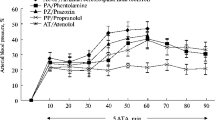Summary
In rats of two age-groups the effects and concentrations in blood and brain of hexobarbital, barbital and thiopental have been studied.
The sleeping time after hexobarbital is longer in old rats than in just matured animals (3 months of age) because the enzymatic oxidation of hexobarbital in old rats is slower.
After barbital which is eliminated chemically unchanged, the duration of anaesthesia is equal in both age groups.
The duration of thiopental anaesthesia with small doses is not different in the two age groups. At a higher dose, however, the larger extracerebral volume in the older animals becomes significant so that the older rats do not sleep as long as the younger ones.
When 45 mg/kg or more of thiopental has been given, the drug concentration in the brain remains above the anaesthetic level, even after the extracerebral volume has been filled up. Therefore as a first approximation sleeping time becomes a function of metabolic degradation of thiopental which is slower in old than in young rats as with hexobarbital.
Regarding the time course of the fall and recovery of body temperature during narcosis at 22° C there was no significant difference between the two age groups.
Similar content being viewed by others
Literatur
Brodie, B. B., Burns, J. J., Mark, L. C., Lief, P. A., Bernstein, E., Papper, E. M.: The fate of pentobarbital in man and dog and a method for its estimation in biological material. J. Pharmacol. exp. Ther.109, 26 (1953).
—, Mark, L. C., Papper, E. M., Lief, P. A., Bernstein, E., Rovenstine, E.: The fate of thiopental in man and a method for its estimation in biological material. J. Pharmacol. exp. Ther.98, 85 (1950).
Carmichael, E. B.: The median lethal dose of pentobarbital sodium for both young and old rats, J. Pharmacol. exp. Ther.62, 284 (1938).
—: The median lethal dose (LD 50) of penthotal sodium for both young and old guinea pigs and rats. Anaesthesiology8, 589 (1948).
Fähndrich, E., Hadass, H.: Relationship between the perazine concentration in the liver, brain and blood and the pharmacologic effects and chronic perazine medication in rats of different age. Pharmakopsychiat.2, 109 (1969).
Farner, D.: Untersuchungen über Wirkungen von Pharmaka auf Tiere verschiedenen Alters. Gerontologia (Basel)5, 35–54 (1961).
—: Untersuchungen über die Wirkung von Pharmaka auf Tiere verschiedenen Alters. V. Mitteilung. Gerontologia (Basel)6, 163–167 (1962).
—, Verzar, F.: The age parameter of pharmacologie activity. Gerontologia (Basel)4, 147 (1960).
Held, K., Gottstein, U.: Die Hirndurchblutung im Alter. Aus: Schlafstörungen im Alter und ihre Behandlung, S. 10–17. Symposium am 19. 3. 1966 in Oberstdorf.
Hügin, F., Verzar, F.: Versagen der Wärmeregulation bei alten Tieren. Gerontologia (Basel)1, 91–106 (1957).
Kärber, G.: Beitrag zur kollektiven Behandlung pharmakologischer Reihenversuche. Naunyn-Schmiedebergs Arch. exp. Path. Pharmak.162, 480 (1935).
Kato, R., Vassanelli, P., Frontino, G., Chiesara, E.: Variation in the activity of liver microsomal drug metabolizing enzymes in rats in relation to age. Biochem. Pharmacol.13, 1037–1044 (1964).
Munde, T. J., Viamonte, L.: Studies on chloral-hydrate and camphor sensivity in rats of different ages. Gerontologia (Basel)13, 165–172 (1967).
Oduah, M.: Die Effektivität und Wirkungsdauer von Thiopental beim Menschen in Abhängigkeit vom Alter. Anaesthesist18, 308–310 (1969).
Oldendorf, W. H., Kitano, M.: Isotope study of brain blood turnover in vascular disease. Arch. Neurol. (Chic.)12, 30 (1965).
Remmer, H.: Geschlechtsspezifische Unterschiede in der Entgiftung von Evipan und Thiopental bei Ratten. Naunyn-Schmiedebergs Arch. exp. Path. Pharmak.233, 173 (1958).
—: Der beschleunigte Abbau von Pharmaka in den Lebermikrosomen unter Einflu\ von Luminal. Naunyn-Schmiedebergs Arch. exp. Path. Pharmak.235, 279 (1959).
Streicher, E., Garbus, J.: The effect of age and sex on the duration of hexobarbital anaesthesia in rats. J. Geront.10, 441–444 (1955).
Trevan, I. W.: The error or determination of toxicity. Proc. roy. Soc. B101, 483 (1927).
Verzar, F.: Einfluß von Graviditäten auf das biologische Alter der Ratte. Gerontologia (Basel)7, 77 (1963).
Author information
Authors and Affiliations
Rights and permissions
About this article
Cite this article
Kuhlmann, K., Oduah, M. & Coper, H. Über die Wirkung von Barbituraten bei Ratten verschiedenen Alters. Naunyn-Schmiedebergs Arch. Pharmak. 265, 310–320 (1970). https://doi.org/10.1007/BF00997189
Received:
Issue Date:
DOI: https://doi.org/10.1007/BF00997189



